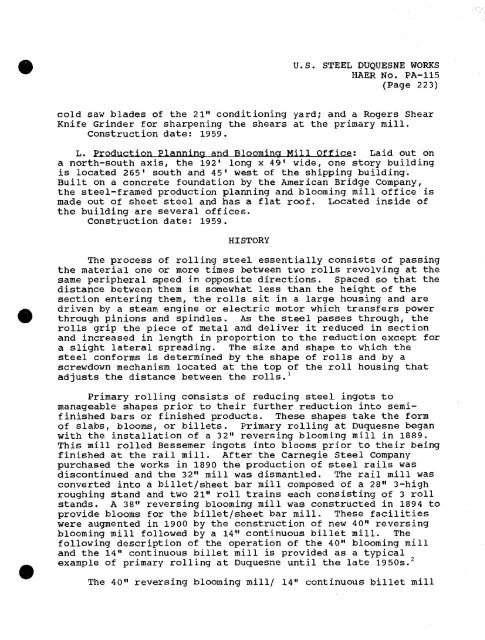pa1778data.pdf
pa1778data.pdf
pa1778data.pdf
Create successful ePaper yourself
Turn your PDF publications into a flip-book with our unique Google optimized e-Paper software.
U.S. STEEL DUQUESNE WORKS<br />
HAER NO. PA-115<br />
(Page 223)<br />
cold saw blades of the 21" conditioning yard; and a Rogers Shear<br />
Knife Grinder for sharpening the shears at the primary mill.<br />
Construction date: 1959.<br />
L. Production Planning and Blooming Mill Office: Laid out on<br />
a north-south axis, the 192' long x 49' wide, one story building<br />
is located 265' south and 45■ west of the shipping building.<br />
Built on a concrete foundation by the American Bridge Company,<br />
the steel-framed production planning and blooming mill office is<br />
made out of sheet steel and has a flat roof. Located inside of<br />
the building are several offices.<br />
Construction date: 1959.<br />
HISTORY<br />
The process of rolling steel essentially consists of passing<br />
the material one or more times between two rolls revolving at the<br />
same peripheral speed in opposite directions. Spaced so that the<br />
distance between them is somewhat less than the height of the<br />
section entering them, the rolls sit in a large housing and are<br />
driven by a steam engine or electric motor which transfers power<br />
through pinions and spindles. As the steel passes through, the<br />
rolls grip the piece of metal and deliver it reduced in section<br />
and increased in length in proportion to the reduction except for<br />
a slight lateral spreading. The size and shape to which the<br />
steel conforms is determined by the shape of rolls and by a<br />
screwdown mechanism located at the top of the roll housing that<br />
adjusts the distance between the rolls. 1<br />
Primary rolling consists of reducing steel ingots to<br />
manageable shapes prior to their further reduction into semi-<br />
finished bars or finished products. These shapes take the form<br />
of slabs, blooms, or billets. Primary rolling at Duquesne began<br />
with the installation of a 32" reversing blooming mill in 1889.<br />
This mill rolled Bessemer ingots into blooms prior to their being<br />
finished at the rail mill. After the Carnegie Steel Company<br />
purchased the works in 1890 the production of steel rails was<br />
discontinued and the 32" mill was dismantled. The rail mill was<br />
converted into a billet/sheet bar mill composed of a 28" 3-high<br />
roughing stand and two 21" roll trains each consisting of 3 roll<br />
stands. A 38" reversing blooming mill was constructed in 1894 to<br />
provide blooms for the billet/sheet bar mill. These facilities<br />
were augmented in 1900 by the construction of new 40" reversing<br />
blooming mill followed by a 14" continuous billet mill. The<br />
following description of the operation of the 40" blooming mill<br />
and the 14" continuous billet mill is provided as a typical<br />
example of primary rolling at Duquesne until the late 1950s. 2<br />
The 40" reversing blooming mill/ 14" continuous billet mill

















